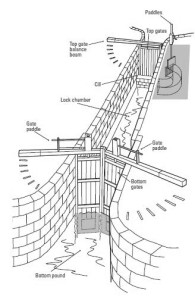The canal system of Great Britain relies heavily on a system of locks that enable the canal to rise and fall over hills and other high ground. Some canal builders tried to avoid putting expensive locks on the stretch of the canal they were constructing, relying instead on following the contours of any hill to maintain a level. However, there was some area of the country where this was either impossible or involved long and expensive detours.
Locks on wide canals tend to be of the mitre gate variety, that is, both top and bottom gates form a pair that comes together in a wedge shape that is held closed by the pressure of the water above them.

Water is then emptied from (or into) the lock depending on whether the boat is climbing or descending a flight, by means of paddles. These are usually lifted by using a windlass to turn ratcheted paddle gear on the lock side, or the gate itself. A boat can only pass through the gates once the water level in the lock is identical to that outside.
Don’t try and force the gates – there may be only half an inch difference in the water level inside and outside the lock, but a quick mental calculation should tell you that half and inch, multiplied by the width and length of the pound of water between locks weighs far too much to move. You’ll only hurt yourself in the process.
Normal procedure to go up in a lock which was set against you would be:-
1. Tie up on the bollards below the lock
2. Empty the water from the lock by ensuring the paddles are down on the top gates – then opening the bottom gate paddles.
3. Open the gate and enter the lock.
4. Close the gates – and make sure that you lower the bottom paddles fully.
5. Secure the boat and open the top paddles. Where a lock has gate mounted paddles as well as ground paddles, don’t be tempted to open these until the rising water has covered them – apart from buffeting the boat around, there is a danger you could flood the front of the boat.
6. Once the water level has equalised, open the top gates, drop the paddles carefully, move the boat out and close the gate behind you.
A note on windlasses – these come in a baffling array of styles and materials from steel and aluminium to posh brass ones often only used for festivals – (as it gives their owners something else to polish!) There are even some on the market that have a ratchet mechanism built in to gain extra leverage and make the lifting process easier.
BUT – whatever design you opt for, under no circumstances should you leave the windlass on the spindle of the lock mechanism unattended. Once you have wound the paddle up or down – remove the windlass. If a paddle were to drop inadvertently, a spinning windlass can fly off in any direction and is a real danger to boat and crew – and I have personally seen someone break a thumb trying to stop a whirring windlass.


